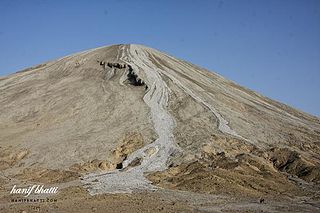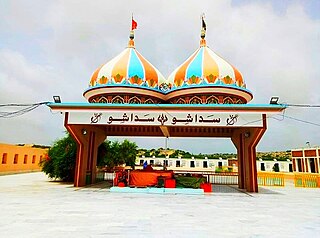This article needs additional citations for verification .(July 2015) |
Kapadi, also known as Kapdi is a small community in Gujarat, India. [1]
This article needs additional citations for verification .(July 2015) |
Kapadi, also known as Kapdi is a small community in Gujarat, India. [1]
The Kapdi Sampradaya claim to be descendants of Raja Raghu who is an ancestor of Lord Rama, the guide of the Hindu deity Rama, Rama's army as they marched through the desert to Hinglaj. [2]
This dress was given by Rama to one Laljusraj, who accompanied him on the trip. Laljusraj is said to be the founder of the Kapdi sect in Hinglaj. It is believed that it is the same dress, that is preserved at Mekan Dada Temple at Dhrang. [3]
They worship Ashapura Mata and make visit the Hinglaj Mata mandir in Balochistan, Pakistan. [4]
The Kapdis consider Mekan Dada to be an incarnation of Lakshmana, the younger brother of Rama, and he visited the site of Hinglaj at the end of the 17th century. The Kapadis consider anyone who performs the pilgrimage to Hinglaj to be Kapdi as well. [2]
Bhatia is a group of people and a caste found in Punjab, Sindh and Gujarat. Traditionally, they have been a trading and merchant community. The Bhatias primarily live in Northwestern India and Pakistan. The Bhatias, Lohanas and Khatris were similar communities and were known to intermarry. The Bhatias recruit Saraswat Brahmins as priests.
Lohana are a trading or mercantile jāti mostly in India and also in Pakistan.

The Hingol mud volcanoes are located in Lasbela District, Balochistan, Pakistan at a distance of around 100 km from Uthal, which is the headquarter of District Lasbela. The mud volcanoes are located in Hingol National Park which is the largest national park in Pakistan. It contains about ten clusters of mud volcanoes, the most important of which are Chandragup and Khandewari volcanoes.

A kuladevata, also known as a kuladaivaṃ, is an ancestral tutelary deity in Hinduism and Jainism.

Karni Mata Temple of Deshnoke, also known as Madh Deshnoke, is a prominent Hindu temple dedicated to Karni Mata at the town of Deshnoke, located 30 km south of Bikaner, in Rajasthan. It has become the most important pilgrimage site for devotees of Charanisagatis after access to Hinglaj was restricted following the partition of India. The temple is also a popular destination for tourists and pilgrims and is renowned, both in India and internationally, as the "Temple of Rats" due to the numerous rodents known as kābā which are considered holy and treated with utmost care by devotees. This is sometimes upheld as exemplary of an "environmentally conscious Hindu ethos". The temple draws visitors from across the country for blessings, as well as curious tourists from around the world.

Hinglaj Mata, also known as Hinglaj Devi, Hingula Devi and Nani Mandir, is a Hindu temple in Hinglaj, a town on the Makran coast in the Lasbela district of Balochistan, and is the middle of the Hingol National Park. It is one of the 51 Shakti Peethas in Shaktism denomination of Hinduism. It is one of the three Shakti Peethas in Pakistan, other two being Shivaharkaray and Sharada Peeth. It is a form of Durga or Devi in a mountain cavern on the banks of the Hingol River. Over the last three decades the place has gained increasing popularity and became a unifying point of reference for Pakistan's many Hindu communities. Hinglaj Yatra is the largest Hindu pilgrimage in Pakistan. More than 250,000 people take part in the Hinglaj Yathra during the spring.

Hinglaj is an important Hindu pilgrimage place in Balochistan, Pakistan and Kuldevi of many Rajput, Charan, Rajpurohits and other Hindu Communities of India. It is situated in Balochistan province about 250 km west-northwest of Karachi. The Shri Hinglaj Mata mandir which is the largest Hindu pilgrimage centre in Pakistan is located here.

The Shri Swami Narayan Mandir, Karachi is a Hindu temple that is the only Swami Narayan temple in Pakistan. The temple is notable for its size and frontage, over 32,306 square yards (27,012 m2) on the M. A. Jinnah Road in Karachi city. The temple celebrated its anniversary of 216 years in April 2004. There is a sacred cowshed within the premises of this temple. The temple is located at the centre of a Hindu neighbourhood in Karachi. The building that housed a dharmshala for visiting devotees has now been converted to the office of the City District Government.

Tanot Mata is a temple in the western state of India in District Jaisalmer of Rajasthan.
Sant Mekan Dada or Mekan baba was a Sufi saint from Kutch, Gujarat, India.
Dhrang or Dhrung is a small village located in Kutch District of Gujarat State of India. The village is on border to Pakistan. The other known village nearby is Lodai.
Bhanushali is a Hindu community. The majority reside in Kutch district of the Indian state of Gujarat. Some are also found in the Saurashtra region and other parts of Gujarat. Some have also moved to Thane and Mumbai region of Maharashtra. They speak Kutchi language which is alike Gujarati.

The Kalka Devi Temple, Kalka Devi Cave Temple or Kalka Devi Mandir is one of the holiest Hindu temples in Pakistan. It is situated inside a natural cave in the Kalka hills in Aror, Sindh province, Pakistan. The temple is known as the Asthan of Kalka Devi. It is visited by both Hindus and Muslims. Hindus from India also visit. The majority of devotees visiting the temple are Muslims.

The Panchmukhi Hanuman Mandir is a historic Hindu mandir in Karachi, Pakistan The mandir was declared as a national heritage under the Sindh Cultural Heritage (Preservation) Act 1994 and is believed to be at least 1,500 years old.

Rama Temple, also known as Ram Kund Temple, is situated in Saidpur Village, Islamabad, Pakistan. The temple is dedicated to the Hindu God Rama, who Hindus believe lived in the area with his family during 14 years of their exile. The temple was built in the 16th century by Man Singh I.

Parbraham Ashram or Parbirham Ashram or Faqir Parbraham ashram or Parbraham Ashram Verijhap is an ashram located in Verhi Jhap village in Diplo in Tharparkar district in the Sindh Province of Pakistan. The ashram is famous for its annual Dada Parbriham Mela which is participated by a large number of Hindus from Sindh and Balochistan.

Hinduism is a minority religion in Balochistan followed by 0.41% of the population of the province. It is the largest minority religion in Balochistan. The Balochistan is home to the shrine of Shri Hinglaj Mata temple, which is one of the most sacred Hindu temples. The annual Hinglaj Yatra to the temple is the largest Hindu pilgrimage in Pakistan.
Brohi Charan are a Brahui, Sindhi speaking ethno-linguistic group residing in the Sindh and Balochistan provinces of Pakistan. Brohi Charans are the traditional priests of the Hinglaj shrines in Balochistan and Thatta.

Viratra Vankal Mata Temple a 900-year-old temple of Mother goddess Vankal situated on a hilltop called Viratra, located in Barmer of Rajasthan.